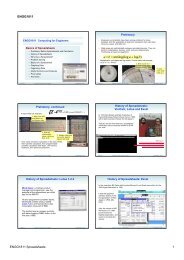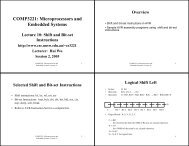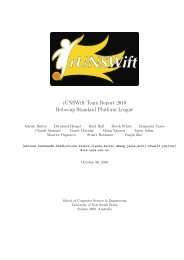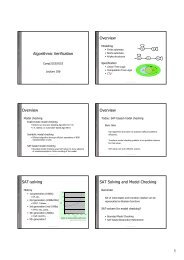Dual-pipeline heterogeneous ASIP design - School of Computer ...
Dual-pipeline heterogeneous ASIP design - School of Computer ...
Dual-pipeline heterogeneous ASIP design - School of Computer ...
Create successful ePaper yourself
Turn your PDF publications into a flip-book with our unique Google optimized e-Paper software.
esentation depictin the de endency <strong>of</strong> instructions in an<br />
instruction trace, wfere nocfes represent instructions, and<br />
directed edges represent dependency. A node has a ty e<br />
that corresponds to the type <strong>of</strong> instruction it represents. in<br />
instruction is dependent on another if the first instruction<br />
can only be executed after the second is completed. Some<br />
dependent instructions can he executed simultaneously (for<br />
example see lines 4 and 5 in Figure 6(b), which can he ex+<br />
cuted together due to the <strong>pipeline</strong> execution)<br />
Definition 2: Connected Graph, y. The subgraph <strong>of</strong> G,<br />
where all nodes in<br />
are connected by directed edges.<br />
Definition 3: lssociated Graph Set, 9. The set <strong>of</strong> con-<br />
nected graphs that contain nodes <strong>of</strong> a given type. For an<br />
instruction, Insl in the instruction set, its Assoczated Graph<br />
Set is denoted by Pi.<br />
Definition 4: Dependency Depth. The depth <strong>of</strong> a node<br />
in a connected gra h, y, from the starting nodes. A starting<br />
node is not de enzent on any other nodes and has a depth<br />
<strong>of</strong> 1. The totardepth <strong>of</strong> graph g is denoted by d,.<br />
Figure 5: Example <strong>of</strong> Instruction Graph<br />
Y . I<br />
Graph Set, QI = {gl,yZ}. For Ins3, its Associated Graph<br />
set, IS = {gl}. For Insl in suh-graph gl, the depth <strong>of</strong> node<br />
1 is 1 and the depth <strong>of</strong> node 5 is 4.<br />
It is ossible for any instructions with the same dependency<br />
&pth to be grouped in pairs for parallel execution.<br />
Take the instruction nodes 6 and 7 <strong>of</strong> graph 82, in Figure<br />
5, as an example. Both have the same depth, therefore<br />
they can be grou ed into a parallel execution pair. For instructions<br />
in didrent connected raphs, because there is<br />
no dependency, they can always form the parallel execution<br />
pairs. For example, instruction node 6 in g2 can be<br />
paired with any instruction node in gl. But this inter-ymph<br />
matching may result in longer execution. For example, by<br />
grouping instruction nodes 5 and 6, gl and g2 are put in<br />
sequence. The overall execution time will be at least 8 instruction<br />
cycles. As such, it is advisable to match parallel<br />
instructions locally within connected graphs. Only left-over<br />
instructions are considered for inter-graph matching. The<br />
following definition formalizes the parallelizability.<br />
Definition 5: Instmction parallelizability, a. The pu<br />
teutial for an instruction to he executed in parallel with<br />
another instruction <strong>of</strong> the same type. For instruction Ins,,<br />
it is defined as<br />
1<br />
0% = E(LPt +GPi),<br />
(1)<br />
where N is the total number <strong>of</strong> instructions in the target<br />
instruction set; and LPe denotes the intra-graph parallelism<br />
<strong>of</strong> Instruction i, and is defined as<br />
where k, is the number <strong>of</strong> nodes (representing Ins;) <strong>of</strong> depth<br />
j in graph y, I'PliI is the number <strong>of</strong> elements in set 9,; and<br />
(3)<br />
where the first part <strong>of</strong> the product stands for avera e left<br />
over instructions per connected graph. Therefore, GJ, gives<br />
an approximate value <strong>of</strong> possible instruction matching pairs<br />
across the connected graphs.<br />
We use the D value to estimate how <strong>of</strong>ten two <strong>of</strong> the same<br />
instruction type can be scheduled simultaneously.<br />
Definition 6: instmction cost, c. The area overhead,<br />
due to augmenting the basic processor hy implementing the<br />
instruction.<br />
Based on the above definitions, we define the implemen-<br />
tation efficiency for an instruction as follows.<br />
Definition 7: Implementation eficiency, 7. Given an<br />
instruction, Ins,, from the tar et instruction set, assume the<br />
cost for the instruction is c; an$ its parallelizability is, ai, the<br />
implementation efficiency <strong>of</strong> implementing the instruction in<br />
both pipes is qa = o ,/~<br />
In order to determine whether to implement an instruction<br />
in two pipes, we set a criteria value, denoted by 0. An<br />
instruction is implemented in both pi es if 7 2 0. The<br />
value 0 could he derived in many didrent ways. We use<br />
an average-value based scheme by using the average value<br />
<strong>of</strong> o and c over all instructions, which can be implemented<br />
on both <strong>pipeline</strong> paths. Assume the number <strong>of</strong> instructions<br />
(implementable in both paths) in the instruction set is m,<br />
Ins.<br />
2: Is1<br />
mov<br />
mu1<br />
c a 7<br />
E? : :<br />
0.04<br />
0.004<br />
0.12<br />
0<br />
0.22<br />
0.11<br />
0<br />
55<br />
0.92











